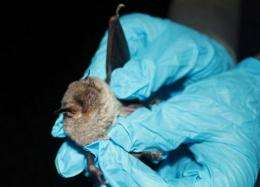Killer fungus spreads to endangered gray bats: US

A deadly fungus that has wiped out large populations of bats in North America has spread to a new species, the endangered gray bat, US wildlife officials said Tuesday.
White-nose syndrome (WNS) was found in several gray bats in the southeastern state of Tennessee, though there was no sign that the disease had yet killed any of the endangered creatures, the Fish and Wildlife Service said.
"While no mortality has been observed in gray bats that can be linked to WNS, the confirmation that gray bats can be infected is cause for concern," it said in a statement.
The fungus has been documented in 19 US states and four provinces of Canada since it first emerged in 2006, and has killed nearly seven million bats according to experts' estimates.
It had previously been found in six different species of hibernating bats, including the endangered Indiana bat.
The disease can cause unusual behavior in bats that typically hibernate through the winter, resulting in clusters of bats near cave entrances and some of the nocturnal creatures venturing outside during the day.
These activities can deplete the bats' energy reserves and cause them to die prematurely.
Gray bats were listed as endangered in 1976. Most live in a small number of caves in the southeastern United States, making them particularly vulnerable to disturbances like disease or human intrusion.
Bats are valuable as natural pesticides because they eat lots of insects, and the loss of the bats has raised concerns among farmers and biologists alike.
"The news that another federally endangered bat species, the gray bat, has been confirmed with white-nose syndrome is devastating for anyone who cares about bats and the benefits they provide to people," said FWS director Dan Ashe.
A US study last month in the Proceedings of the National Academy of Sciences suggested that the fungal disease was likely introduced into a New York cave by a visitor from Europe.
For now, experts have no way to treat or cure the epidemic, which has swept 2,000 kilometers (1,200 miles) across the United States and into Canada, killing up to 97 percent of the bats in colonies it afflicts.
"We are not sure what this diagnosis is going to mean for gray bats and the spread of WNS," said Jeremy Coleman, National WNS Coordinator for the Service.
"Individual bat species appear to respond differently to WNS, and only research and time will reveal where gray bats fit on the spectrum."
(c) 2012 AFP

















